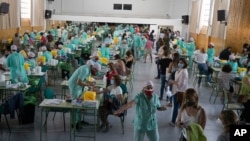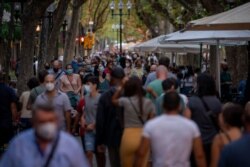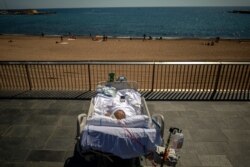Deirdre Carney suspected she might have COVID-19 when her temperature began to fluctuate above the normal 37 degrees Celsius.
"It was a bit of a shock when I was diagnosed. I could not believe that I had got it. I had not mixed with that many people," Carney, an English teacher from California living in Madrid, told VOA.
In the Spanish capital, which now has about a third of Spain’s coronavirus cases, authorities have been forced to impose several restrictions to try to halt the surge in infections.
Since imposing one of the most draconian lockdowns in Europe, Spain became the first Western European country to report more than 500,000 cases, health authorities said Monday.
With the number of infections reaching 525,000 Tuesday, Spain has 255.9 cases per 100,000 inhabitants, compared to 35.2 in Britain, 125.2 in France and 30.6 in Italy, once one of the worst-affected European countries at the start of the pandemic.
Fighting the disease in isolation, Carney said she was not contacted by case tracers — a key deficiency that experts say is part of the reason for the surge in infections.
"The only people who carried out the tracing was my employer," she said.
New restrictions
Madrid, a city of 6.6 million people who often live in densely populated neigborhoods, will limit social gatherings to 10 people inside or outdoors.
Many outbreaks have been linked to family gatherings or when young people get together for outdoor drinking sessions, known as botellones.
Bars, restaurants, weddings and funerals will also face curbs on capacity.
A new wave of contagion has been less deadly than at the start of the pandemic, and the number of infections seems to have slowed from the daily peak of over 10,000 more than a week ago.
The death rate also remains well below the peak in April when over 900 people died in one day.
Nevertheless, many are asking why Spain has once again become the “Sick man of Europe.”
Experts suggest a complex mixture of factors have conspired to bring the country back almost to square one just as 8 million children return to school and Spaniards head back to work.
“We had a very strict lockdown then relaxed this too quickly in a country with a high propensity to socialize and for family networks to stay very close,” Ildefonso Hernández, a professor of public health at the University Miguel Hernández near Alicante in southeast Spain, told VOA in an interview.
“The picture is not homogeneous, but some regions also failed to employ enough case tracers when outbreaks started. It also has to be said that the number of tests being carried out has increased dramatically since March and April, so we are seeing more positive diagnoses,” he said.
Hernández also said part of the blame lay with regional authorities' responses to migrant fruit pickers who travel around the country getting work where there are harvests. Many are forced to live in cramped conditions in which social distancing is difficult, if not impossible.
“Some authorities, in Catalonia and Aragon, failed to provide adequate accommodation for these people,” Hernandez said.
Worrying situation
In Madrid, the number of hospital beds occupied with COVID-19 cases is approximately 18%, compared with the national average of 7%.
“The situation in Madrid is worrying. The number of COVID-19 cases is putting pressure on the ability of some hospitals to carry out other operations,” Hernández said.
Analysts also point to weaknesses in Spain's system of governance as a factor.
Spain is one of the most decentralized states in Europe, with responsibility for health care and education farmed out to the 17 regional governments.
“At the start of the pandemic, the central government took control over the management of the crisis from the regions. Apart from ideological differences with the central government, some regional pride was peaked,” Miguel Otero-Iglesias, an economist at the Elcano Royal Institute, a think tank in Madrid, told VOA.
“At the same time, the regions look to the center for leadership. Spain does not have a fully centralized government, neither does it have a federal state.”
In order to improve infection tracing, Spain has called in the army, deploying 2,000 specialized soldiers to help regional authorities.
Spanish Health Minister Salvador Illa sought to calm fears.
“The situation now is nothing like it was in March or April in terms of pressure on hospital beds or intensive care units,” he told reporters at a press conference.











